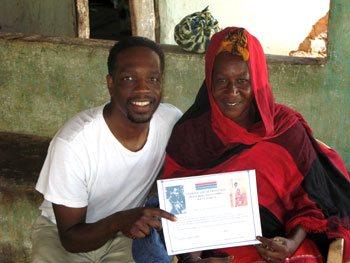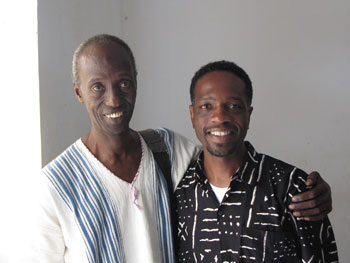Professor Tim Lake’s research in The Gambia took him to the village of Kunta Kinte, the central character of the novel, Roots: The Saga of an American Family, by Alex Haley. The book inspired one of the most-watched television miniseries and, as sociologist Michael Eric Dyson wrote, “helped convince the nation that the black story is the American story.”
 I actually met Alex Haley in 1989 during the Annual African American Family Reunion held on the Smithsonian Mall in Washington, DC. This was the start of a near decade-long reign of Afro-centrism (the popular culture version of the highbrow Afrocentricity theorized by Molefi Kete Asante), when red, black and green medallions with Queen Nefertiti, Africa, and/or a clinched black fist embroidered on it hung from the neck of every truly conscious Afrikan American.
I actually met Alex Haley in 1989 during the Annual African American Family Reunion held on the Smithsonian Mall in Washington, DC. This was the start of a near decade-long reign of Afro-centrism (the popular culture version of the highbrow Afrocentricity theorized by Molefi Kete Asante), when red, black and green medallions with Queen Nefertiti, Africa, and/or a clinched black fist embroidered on it hung from the neck of every truly conscious Afrikan American.
Who can forget those Kufi hats, neckties, and long flowing gowns made out of African print fabrics such as mud and kente cloths? And, of course, those sloganeering T-shirts we wore (“Black to the Future,” “Danger: Educated Black Man,” “Too Black/Too Strong”) that bespoke a quest for self-definition and perseverance as the Reagan years were ending. And Malcolm X was everywhere!
So when, as a 25-year-old intellectual in the making, I shook Haley’s hand on the Mall, it was his work in writing The Autobiography of Malcolm X (1965) that I thought of first.
As a teenager, I had watched every episode of the television miniseries Roots. For me, it was a story of the African American experience (as John Hope Franklin called it, “From Slavery to Freedom”), but later I would see it as one man’s search for a sense of heritage—for family connections.
But today I visited Juffureh and walked the land of Haley’s Kunta Kinte’s birth and capture.

In Juffureh, I was told the story of how the Kintes came to The Gambia and how, as a teenage boy, Kunta was captured by Portuguese traders and taken to St. James Island. He was held on St. James (the first Slave Fort in West Africa) for 14 days before being taken to Goree Island and transported to America where he was sold in Virginia in 1767.
I also visited St. James Island and walked the ground where many of those who comprised the first generation of Africans to enter the Transatlantic Slave Trade began their horrible nightmare of the “New World.” he Gambia is the home of the biennial Roots Heritage Festival, which attracts both continental and Diasporain Blacks. What a peculiar heritage.
It was a great honor to meet a member of the ninth generation of the Kinteh (their spelling) family. I was also thrilled at meeting the Chief of the village—the first female chief in The Gambia.
My chance meeting with Haley 20 years ago was ob-scured by Malcolm’s hagiography. However, the visit to Juffureh has allowed me to see Haley’s Roots as part of our collective heritage.
In a real sense, Kunta is (as my grandmother would say) “kinfolk” to all of us.
Editor’s Note: Assistant Professor of English Tim Lake spent five weeks in Senegal and Gambia with 14 other educators on a Fulbright-Hays Seminar funded by the U.S. Department of Education. Also Director of the College’s Malcolm X Institute of Black Studies (MXIBS), Lake plans to use the research to create a class on the slave trade and to improve African studies at Wabash.
After posting this entry on his blog, Professor Lake received this response from Keith Nelson ’71, co-founder of the MXIBS:
Tim,
Reminds me of Alex Haley’s visit to Wabash in, I believe, 1969. He came to talk about his then unfinished book Roots, but as a Black student, all I wanted to hear about was Malcolm X. Later, when Roots the book, then series, came out. I realized what a unique experience that had been provided to me by Wabash College.
—Keith
Photos
(top left) “It was a great honor to meet a member of the ninth generation of the Kinteh family.”
(lower right) Lake with Dr. Saja Taal, senior lecturer at the University of the Gambia and advocate for higher education reform throughout Africa.
 I actually met Alex Haley in 1989 during the Annual African American Family Reunion held on the Smithsonian Mall in Washington, DC. This was the start of a near decade-long reign of Afro-centrism (the popular culture version of the highbrow Afrocentricity theorized by Molefi Kete Asante), when red, black and green medallions with Queen Nefertiti, Africa, and/or a clinched black fist embroidered on it hung from the neck of every truly conscious Afrikan American.
I actually met Alex Haley in 1989 during the Annual African American Family Reunion held on the Smithsonian Mall in Washington, DC. This was the start of a near decade-long reign of Afro-centrism (the popular culture version of the highbrow Afrocentricity theorized by Molefi Kete Asante), when red, black and green medallions with Queen Nefertiti, Africa, and/or a clinched black fist embroidered on it hung from the neck of every truly conscious Afrikan American. In Juffureh, I was told the story of how the Kintes came to The Gambia and how, as a teenage boy, Kunta was captured by Portuguese traders and taken to St. James Island. He was held on St. James (the first Slave Fort in West Africa) for 14 days before being taken to Goree Island and transported to America where he was sold in Virginia in 1767.
In Juffureh, I was told the story of how the Kintes came to The Gambia and how, as a teenage boy, Kunta was captured by Portuguese traders and taken to St. James Island. He was held on St. James (the first Slave Fort in West Africa) for 14 days before being taken to Goree Island and transported to America where he was sold in Virginia in 1767.